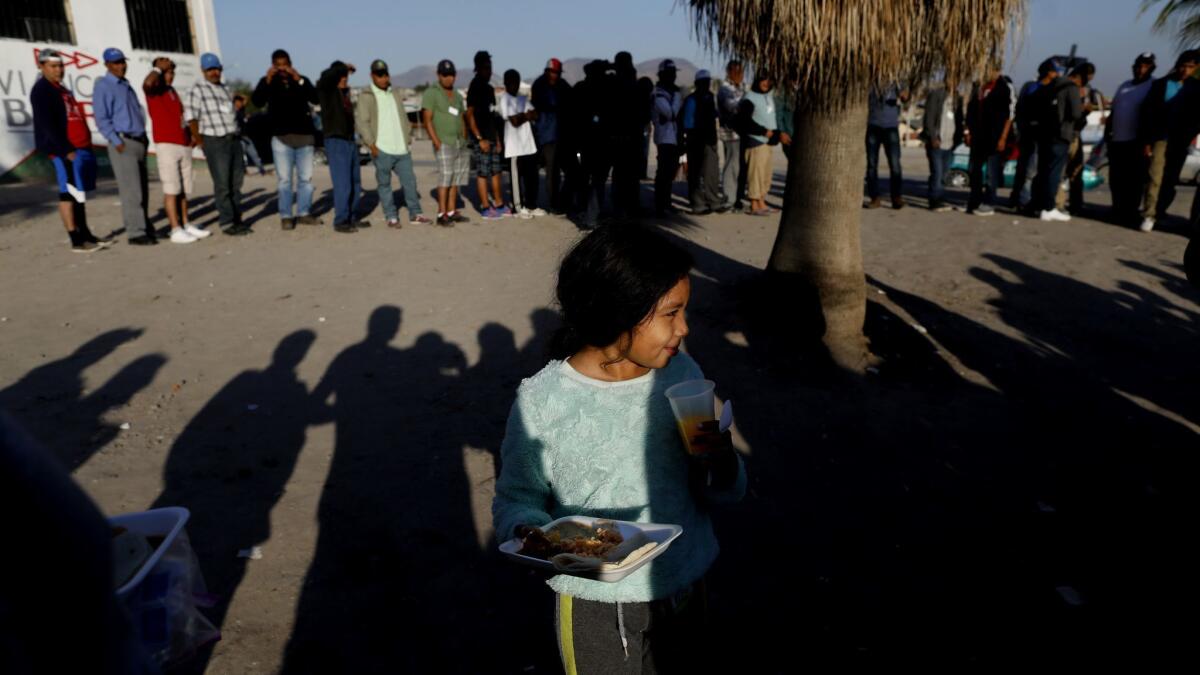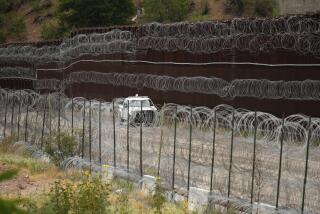Migrants will be forced to remain in Mexico while asylum claims are weighed, U.S. and Mexico agree

Reporting from Washington — Thousands of migrants seeking asylum in the U.S. will be forced to wait in Mexico while their cases are considered — a process that can often take well over a year — the Trump administration and Mexico’s government announced Thursday.
The dramatic change in long-standing U.S. policy will alter life for tens of thousands of Central Americans stuck on the border.
Homeland Security Secretary Kirstjen Nielsen hailed the shift as a historic measure that would “bring the illegal immigration crisis under control.”
“‘Catch and release’ will be replaced with ‘catch and return,’” Nielsen said in a statement.
But opponents called the move a misguided denial of a well-established legal right to seek protection in the U.S. from persecution in other countries.
Rep. Joaquin Castro (D-Texas), incoming chairman of the Congressional Hispanic Caucus, called the new policy “the single biggest assault to date by this administration on the world’s most vulnerable populations coming to America — legally — and in search of a better life.”
Democratic lawmakers and immigration advocates tied the policy shift to Trump’s frustrations over his inability to get Congress to pay for his proposed border wall.
The president is “refusing to admit defeat,” Rep. Bennie Thompson (D-Miss.), the ranking member of the House Homeland Security Committee, said in a statement. “The administration is now hellbent on taking out its frustration on vulnerable people fleeing violence by making our asylum process even more difficult.”
Under current policy, asylum applicants are often detained in the U.S. while their petitions move through the system. Because of the large caseload, lengthy backlog, and a shortage of detention space, many are ultimately given a court date and released, a practice that Trump has repeatedly denounced.
Under the new policy, migrants who enter the United States from Mexico and ask for asylum, whether or not they present themselves to U.S. authorities at a legal port of entry, may be returned to Mexico while they await further proceedings.
That would be a major change for Mexico, which traditionally has refused to accept the return of migrants who aren’t Mexican. Under the new policy, which the U.S. imposed unilaterally, but which Mexico said it would cooperate with on a temporary basis, third-party nationals or non-Mexican migrants will be allowed to remain in Mexico due to humanitarian reasons, officials at Mexico’s embassy in Washington said.
“Mexico reaffirms its sovereign right to admit or reject the entry of foreigners into its territory, in the exercise of its migration policy,” Mexico’s foreign ministry said in a statement, adding that Mexico was taking the steps “for the benefit of the migrants” and to “protect their right” to claim asylum in the United States.
The foreign ministry said Mexico had rejected a U.S. proposal known as “safe third country,” under which Central Americans seeking asylum would generally have to seek protection in Mexico, not in the U.S., similar to a U.S. understanding with Canada . The new policy preserves the right of Central Americans and others arriving at the southwest border to apply for asylum in the United States.
Domestic critics, however, are likely to assail Mexico’s new government for doing Washington’s bidding, a criticism leveled at the previous Mexican administration. At U.S. urging, former President Enrique Peña Nieto bolstered enforcement along Mexico’s southern border, and in recent years, Mexico has deported more Central Americans than the United States has.
Many of the mechanics of the agreement are still being worked out, Homeland Security officials told reporters. Migrants given a “notice to appear” will have access to immigration attorneys and to the United States for court hearings, they said, but how asylum applicants will be notified of changes in court dates and other developments in their cases remains unclear.
Also uncertain is whether their cases would be heard in immigration courts in U.S. border cities such as San Diego and El Paso, or in other venues.
People whose claims are ultimately upheld by U.S. judges will be allowed into the United States, while others will be deported to their home countries, the officials said.
In Tijuana, where the largest group of asylum seekers has waited for U.S. officials to allow them into the San Ysidro Port of Entry for processing, the news surprised migrants and Mexican immigration officials alike.
David Enamorado, a 32-year-old who fled his native Honduras with his wife and three young children, read articles explaining the change aloud to the group from his phone.
“They can’t do that, can they?” one asked.
Two couples from Nicaragua listened, their faces crestfallen. “What are we going to do?” one of the men said.
“If they don’t want us in Nicaragua and they don’t want us in the United States, what do we do?” They would wait, the other man said, for as long as they had to. They didn’t have another option.
Trump has consistently sought to frame the situation at the border as a problem of illegal immigration. He maintains that the southwestern border is being overrun by immigrants crossing illegally, many of whom he claims are criminals and terrorists.
The new policy, however, targets asylum seekers — many, perhaps most, of whom are not violating U.S. laws.
Apprehensions at the border — the most common measure of illegal immigration — are near historical lows. In the fiscal year that ended in September, border authorities apprehended 521,090 people. By comparison, from the 1980s to the mid-2000s, the government usually apprehended more than 1 million migrants a year.
The number of families arriving at the border and asking for asylum, however, has increased, and the administration says that the Border Patrol has been overwhelmed by the surge. In November, Border Patrol agents apprehended 25,172 family members on the border, a record, and 5,283 unaccompanied minors.
In the last five years, Homeland Security has seen a 2,000% increase in migrants claiming credible fear of persecution, the first step in seeking asylum, Nielsen said Thursday, and asylum claims have jumped nearly 70% from 2017. That increase has contributed to the ballooning backlog of asylum cases.
Administration officials argue that most of the claims are fraudulent. They note that while some 80% of asylum seekers pass the first step in the process of seeking refuge — an interview with U.S. officials to determine if they have a credible fear — only 10 to 20% are ultimately granted asylum.
Immigrant advocates, by contrast, say that proving an asylum claim is difficult, especially for migrants who arrive at the border with little documentation to bolster their cases. The “Northern Triangle” countries of El Salvador, Honduras, and Guatemala have in recent years suffered levels of violence and insecurity almost without parallel outside a war zone. Inequality, impunity and high homicide rates attributed to both gangs and state security forces have pushed thousands of migrants north, according to advocates and independent analysts.
The new policy is likely to face court challenges, according to legal experts, immigration advocates and lawmakers.
“Requiring asylum seekers to stay in Mexico is blatantly illegal,” said Kennji Kizuka of Human Rights First, an advocacy group. “The fact that this policy was cobbled together days before a holiday and with no regard to how it will practically function underscores how ill-conceived it is.”
Previous administration efforts to curb asylum claims have fared badly in court. On Wednesday, a federal judge overruled the Trump administration’s guidance that victims of gang and domestic violence should generally not be granted asylum. Earlier, a judge overruled a White House attempt to deny asylum to anyone who entered the United States between ports of entry.
The Trump administration has sought to direct migrants to seek asylum only at official crossings, but U.S. officials have systematically delayed or prevented asylum seekers from making claims there by physically turning them away or by reducing processing to a trickle, citing capacity issues, according to a Dec. 3 joint report by research centers at the University of Texas at Austin, UC San Diego and the European University Institute.
The resulting backlog — along with the new “remain in Mexico” policy — may simply encourage migrants to try to enter the U.S. illegally, experts said.
Alejandro Solalinde, a Catholic priest who runs a migrant shelter in southern Mexico, said he expects many migrants to forgo the asylum process in the United States altogether because of the new agreement.
“So many people have died,” Solalinde said. “And we’re going to see more deaths.”
Wendy Young, president of advocacy group Kids in Need of Defense, was among the immigrant advocates who said that forcing migrants to remain in Mexico will subject them to danger, as organized crime in the country has long targeted migrants.
“We will be forcing children and families to wait indefinitely in dangerous conditions with little to no access to basic services or lawyers to help them claim asylum or other protection,” she said.
Staff writers Kate Linthicum and Patrick McDonnell in Mexico City, Kate Morrissey in Tijuana and Tracy Wilkinson in Washington contributed to this report.
More to Read
Sign up for Essential California
The most important California stories and recommendations in your inbox every morning.
You may occasionally receive promotional content from the Los Angeles Times.










